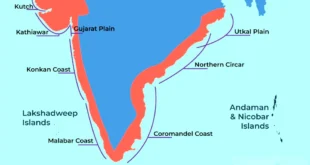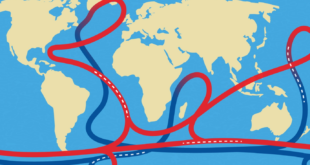- The Sulphur Dioxide (SO2) emissions from a volcanic eruption in the Caribbean (La Soufriere Volcano) have reached India, sparking fear of increased pollution levels in the northern parts of the country and acid rain.
- The Caribbean is the region roughly south of the United States, east of Mexico and north of Central and South America, consisting of the Caribbean Sea and its islands.
Important points:
- It is an active stratovolcano on the Caribbean island of Saint Vincent in Saint Vincent and the Grenadines.
- A stratovolcano is a tall, conical volcano composed of one layer of hardened lava, tephra, and volcanic ash. These volcanoes are characterized by a steep profile and periodic, explosive eruptions.
- Saint Vincent and the Grenadines, located in the southern Caribbean, consists of more than 30 islands and cays, nine of which are inhabited.
- It is the highest peak in Saint Vincent and has had five recorded explosive eruptions since 1718, most recently in April 2021.
- The last time the volcano had erupted was in 1979.
Impact of the Eruption on Global Temperatures:
- Volcanic emissions reaching the stratosphere can have a cooling effect on global temperatures.
- The most significant climate impacts from volcanic injections into the stratosphere come from the conversion of sulphur dioxide to sulphuric acid, which condenses rapidly in the stratosphere to form fine sulphate aerosols.
- The aerosols increase the reflection of radiation from the Sun back into space, cooling the Earth’s lower atmosphere or troposphere.
- Bigger eruptions during the past century have caused a decrease in temperature of 0.27 degree Celsius or more on the Earth’s surface for up to three years.
Sulphur Dioxide and Pollution:
- SO2 emissions that lead to high concentrations of SO2 in the air generally also lead to the formation of other sulfur oxides (SOx). SOx can react with other compounds in the atmosphere to form small particles. These particles contribute to Particulate Matter (PM) pollution.
- Small particles may penetrate deeply into the lungs and in sufficient quantities can contribute to health problems.
Sulphur Dioxide and Acid Rain:
- Acid rain results when sulphur dioxide (SO2) and nitrogen oxides (NOX) are emitted into the atmosphere and transported by wind and air currents.
- The SO2 and NOX react with water, oxygen and other chemicals to form sulfuric and nitric acids. These then mix with water and other materials before falling to the ground.
BRU REFUGEES
- The process of settlement of Mizoram Bru refugees in Tripura has started.
- It is in accordance with a quadripartite accord signed in New Delhi in January 2020.
Important points:
- Bru or Reang is a community indigenous to Northeast India, living mostly in Tripura, Mizoram and Assam. In Tripura, they are recognised as a Particularly Vulnerable Tribal Group.
- In Mizoram, they have been targeted by groups that do not consider them indigenous to the state.
- In 1997, following ethnic clashes, nearly 37,000 Brus fled Mamit, Kolasib and Lunglei districts of Mizoram and were accommodated in relief camps in Tripura.
- Since then, 5,000 have returned to Mizoram in eight phases of repatriation, while 32,000 still live in six relief camps in North Tripura.
- In June 2018, community leaders from the Bru camps signed an agreement with the Centre and the two state governments, providing for repatriation in Mizoram. But most camp residents rejected the terms of the agreement.
- The camp residents said that the agreement didn’t guarantee their safety in Mizoram.
Quadripartite Accord:
- The Centre, the governments of Mizoram and Tripura and leaders of Bru organisations signed a quadripartite agreement in January (2020).
- Under the pact, the Home Ministry has committed to incur the whole expenditure of settlement in Tripura.
- A package was assured in the accord that each refugee family would get:
- A plot, fixed deposit of Rs. 4 lakh, free ration and a monthly stipend of Rs. 5,000 for two years.
- In addition, each family will also be provided Rs. 1.5 lakh to construct a house.
SOURCE: THE HINDU ,THE ECONOMIC TIMES ,MINT
 Chinmaya IAS Academy – Current Affairs Chinmaya IAS Academy – Current Affairs
Chinmaya IAS Academy – Current Affairs Chinmaya IAS Academy – Current Affairs



